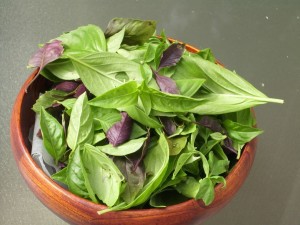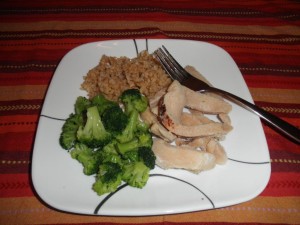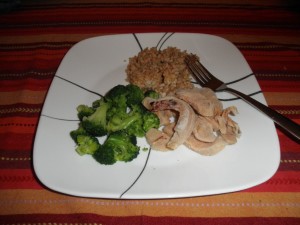It’s that time of year where we resolve to start exercising, eating right, drinking more water and using more recycled bags to the store. I’m sure many of you have set resolutions or even goals. As a nutritionist and coach, I’ve seen such a range of experiences in my clients, and here are a few things I’d encourage you to consider.
- Why is this super-wonderful new habit really important to you now?
Knowing your motivation is a powerful thing, and can help you build in structure to stay focused on what you value most. When I see clients, one my first questions is what they’re hoping to accomplish. When the answer is “Because Dr. So and so says so” or “I know I really should” or “It would make XXX happy” it’s a big red flag and we have to dig deeper and develop personally meaningful goals.
2. What is your baseline?
Often we don’t have a good sense of our current habits. Many people report eating veggies every day or only occasionally going on a Starbucks run, but when they record their food for a few weeks, it becomes clear that the reality is quite a bit different. I definitely recommend keeping track of food, exercise or other habits the old fashioned way with pen and paper, on a website like www.sparkpeople.com or www.nutritiondata.com or on an app like My Fitness Pal or Lose it. In fact, tracking your food is one of the top recommendations from the National Weight Control registry.
Take a look at those two pictures. Which has more food? Actually, it’s the very same food, photographed on a 11 inch plate on the left and a 9 inch plate on the right. Research shows we eat about 30% on the bigger plate. Amazing how much of a difference small choices in our environment can make! We live in a super-sized culture, and almost all of us fall prey to the ginormous sizes we see all around us. Studies show that everything from portion sizes to plates to colors or even names of food dramatically change our intake, and often small tweaks can significantly change our behaviors. If you haven’t read Brian Wansink’s Mindless Eating, it’s a fantastic read with a nice mix of research and easy tools to incorporate in your daily routine.
Most of us live pretty distracted lives. If we’re not paying attention to our life, we’re missing out on the fun! It’s easy to eat while checking email, watching TV, or even driving, and that cuts down on our awareness of portion and on our enjoyment of food. When we’re eating mindfully, we’re much more aware of hunger and fullness, and it’s much easier to stop eating because we’re full than because we’re only allowed a certain amount. Additionally, mindfulness has a huge range of health benefits, from improving depression, to blood pressure, to immunity to diabetes and much more. I’ve got a lot of the research on the benefits of mindful eating here.
5. Do you have support?
Generally, healthy habits take a village. It’s easier to get up on those cold, dark mornings when you’re meeting a friend or you’ve got a four-legged friend who wants to go for a run. Likewise, it’s easier to eat well with support than constantly seeing tempting foods that are off-limits. It’s critical to build in support in person or online for a sense of accountability.
~~~~~~~~~~~~~~~~~~~~~~~~~~~~~~~~~~~~~~~~~~~~~~~~~~~
I know there are so many variations on gluten-free, so here are a wide variety of gluten-free recipes sites that can help you get going, too.
- Bob’s Red Mill features many gluten-free and whole grain recipes. Search under “gluten-free”
- Dr. Weil has great healthy recipes listed. Most (not all) are GF
- Diet, Dessert and Dogs (now Ricki Heller.com): Gluten-free? (check!) dairy-free? (check!) vegan? (check!) delicious? (check!) Ricki’s recipes are wonderful , no matter your food restrictions, and many are grain-free as well. She also has a variety of e-books on her website. *note–there are a few gluten-full recipes still lurking on older pages, so keep an eye out for spelt or barley flour.
- Elana’s Pantry: Curious about almond flour? Elana’s pantry should be your first stop! She also has a lot of wonderful veggie recipes and tips for children, too.
- Ginger Lemon Girl: Most of the newer recipes are paleo friendly, most of the older ones are decadent, but all are gluten-free
- Gluten-free Goodness: my blog, which is gluten, dairy, egg, corn, soy and usually sugar free. Most of the time the recipes are healthy.
- Gluten-free For Good. Great gluten-free and healthy recipes and information on healthy foods, too.
- Health-e-Recipes from AICR (American Institute for Cancer Research). You can sign up for newsletters on their site, and you get weekly recipes in your inbox. Many (not all) are gluten-free and dairy free. Many are quick and simple, use seasonal ingredients, and feature a lot of veggies.
- Kalyn’s Kitchen: Mostly low carb, and everything I’ve made has been delicious. Many food recipes (not just desserts) and many, but not all are gluten-free.
- Simply Sugar and Gluten Free—Amy’s website and cookbook have a lot of wonderful options.
- Spicy RD Nutrition: Fellow RD EA Stewart shares a wide variety of beautiful gluten-free recipes on her website.
- The Spunky Coconut: Kelly’s recipes often include beans and veggies in unusual, but tasty ways. Many are grain-free and allergen friendly, all are gluten-free.
- Vegan, (almost entirely) gluten-free cookbooks from Vitalita by Mark Foy. There are two free downloadable books. Even if you’re not vegan, it’s yummy! Vegan cookbooks are a great resource if you can’t eat dairy or eggs.
- Whole Life Nutrition Kitchen http://www.nourishingmeals.com/ Gluten-free, healthy whole food based meals
- World’s Healthiest Foods: Good, basic healthy recipes. Most are gluten-free, but you can check off the foods you want to avoid for a recipe search.
I have even more recipe & sites listed at http://www.harriswholehealth.com/recipes/ And, of course, there are more websites and resources popping up every day! Do you have a favorite healthy recipe site that isn’t listed? Leave me a comment and let me know!
~~~~~~~~~~~~~~~~~~~~~~~~~~
New Live Webinar on Jan 15th, 2pm-4pm EST
Join me for a 2 hour webinar on “Celiac Disease: What Every RD Should Know” through Dietitian Central.
Upon successful completion of this 2 hour course, the participant should be able to:
- Understand the biology behind Celiac disease
- Recognize our changing understanding of the symptoms of Celiac, prevalence, etc.
- Describe which testing methods are scientifically valid
- Identify which foods have gluten
- Find gluten on labels in live exercises
- Discuss the new laws for 2014 and how they affect clients
- Describe current controversies around alcohol and current controversies
- List foods at high risk of cross-contamination
- Identify the best resources for RDs and clients
To register, see Dietitian Central’s site.
Harris Whole Health offers individual sessions, family sessions and group classes to help people eat healthier and feel better! Cheryl works with people to feel and look their best with a range of specialties, including Celiac Disease, food allergies, pregnancy, breastfeeding, vegetarian and vegan diets, preventing diseases and “whole foods” eating. Let’s get you on your way to achieving your goals. For an appointment with Cheryl Harris, Registered Dietitian and Nutritionist, please click here, email or call 571-271-8742.
To subscribe or unsubscribe, see www.harriswholehealth.com




